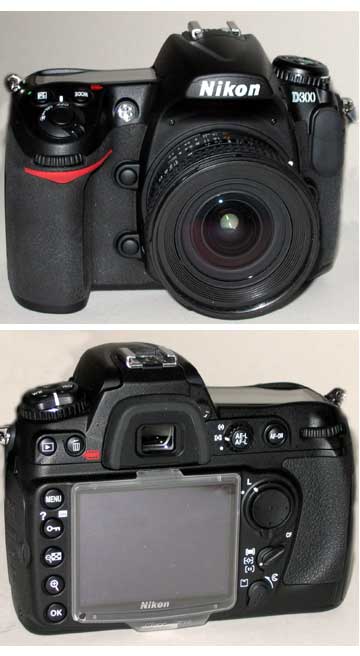The Nikon F set the standard for professional slingle lens reflex cameras from its introduction in 1959.
The Nikon F was the first Japanese SLR to have a lens lineup from 21mm to 1000mm. It was the first SLR with a 100 percent finder so the photographer sees exactly the area that will be recorded on the film. The F was the first Japanese SLR with interchangable focusing screens and was one of the first SLRs with mirror lockup. It also offered a full line of professional accessories, including a 250 exposure back.
When introduced the Nikon F did not have an internal metering system. Later a finder was introduced that metered externally. The camera really hit stride when the TTL FTn finder was introduced that could provide accurate exposure readings while keeping the aperture wide open for focusing.
The biggest negative for the Nikon F was the lack of a hinged back. To load the camera the back has to be removed completly a put aside because inserting the film is a two-handed job. It also has a proprietary shoe that mounted the flash over the rewind crank (hardly anyone used it), The shutter release is not threaded for a standard cable.
The biggest selling point for the Nikon F, besides the quality of the Nikkor lenses, is its construction. It is nearly indestructible -- a major consideration for professionals -- especially photojournalists who often worked under terrible conditions, thousands of miles from the nearest repair shop.
By the time production ended in 1974, 862,600 Nikon Fs had been produced.
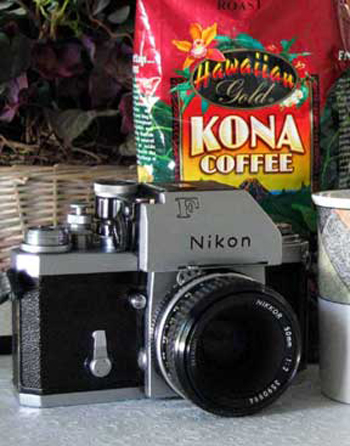
The Nikon F changed photography. The F was introduced in 1959 and was the first camera with and instant return mirror and auto diaphram. The F borrowed a lot of engineering from the Nikon SP rangefinder camera. The first model had a detachable pentaprism finder with no meter. During the next decade several differnt versions of a metering finder were developed -- the last being the FTn finder introduced in 1968, The Nikon FTn was my primary camera for a decade.
The FTn had an auto indexing finder. Thefinder has a 60-40 meter balance. Sixty percent of the meter reading was taken from a 12 percent circle in the center of the picture, the remaining 40 percent from the remainder.
One of the most amazing things about the F is the bayonet lens mount. It has not changed in almost 60 years -- lenses built for the original F will mount on modern Nikon cameras including digital models. The old lenses can't take advantage of developments like auto focus and some metering modes but they will operate on all but a few newer Nikon cameras.
The Nikon F didn't offer any earthshaking features but it did provide legendary reliability, outstanding optics and a full "photographic system," including lenses in a variety of focal lengths, several different finders and motor drives.
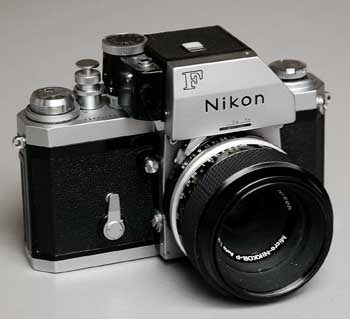
Nikon F2
The Nikon F2 was introduced September 21, 1971. The
F2 was designed with a great deal of input from Nikon F users.
The F2 has a
hinged back. The finders for the F2 have a much lower profile, in part
because the batteries were moved to the camera body. But the shutter in
the camera still is entirely mechanical. On the Nikon F the motor drive
has to be fitted to the individual camera. The F2 motor drive simply attacheds
to the bottom of the camera. The use of titanium in the reflex mirror
frame made it possible to increase the speed of the motor drive. The F2
also uses moder silver rather than mercury batteries.
Several finders were used on the F2. The last model was the F2AS which had a diode readout and could meter with either non AI or AI lenses.
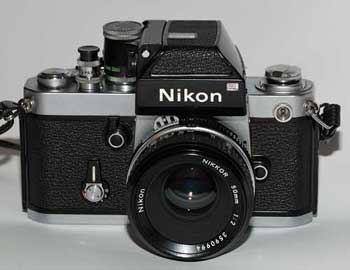
NIKKORMAT
FT3
The
Nikkormat FT3 is one of my most treasured cameras. It was only made two
years --1978 and 1979. It was one of the first Nikons (and the first Nikkormat)
to be able to use auto indexing lenses. The indexing pin on the les mount
would also swing out of the way so the older non-AI lenses would mount
and it was possible to meter using the stop down button. The FT3 also
used silver batteries rather than the now illegal mercury batteries.
The FT3 was designed for pros and advanced amateurs who usually shot with the F2 but wanted a solid but less expensive backup body. It has the classic NikonIf you find an FT3 today it probably still works. The camera is built like a tank. It is one of the last Nikon models built by hand rather than by machine. It has the classic center-weighted 60-40 metering system, a split image focusing screen and the tried and true copal shutter that syncs with electronic flash at 1/125 sec. It was also the last Nikkormat with the shutter speed dial and lever on the lens mount. It also has a hot shoe flash mount on top of the pentaprism. Note: The eyepiece for the FT3 almost always seems to be missing on cameras offered for sale and they can be hard to find and fairly expensive to replace. One gets the feeling sellers are removing them and selling them seperately.
The FT3 is a large camera when compared to the Nikon FM which was introduced at about the same time to compete against the Olympus OM1. That's why the FT3 was only around two years. Comsumers decided smaller was better. The FM flew off the shelves and the FT3 didn't.
I have owned most of the Nikon film camera line over the years -- from the F to the F4 and the F100. But I have to say I have a special place in my heart for the Nikkormat FT3. Maybe it is because it was one of the last totally mechanical Nikons. Maybe it's because it is hand built. Maybe it's because some of my favorite images were shot with it. Or maybe it's becaise it just feels "right." in my hand. In any case, it's a real classic.
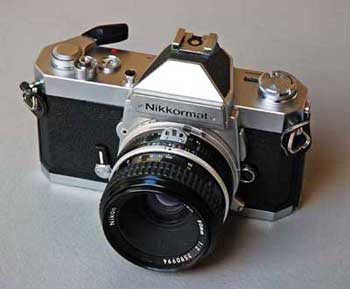
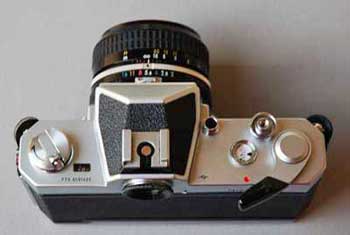
The Nikon FM was Nikon's first small, lightweight SLR. Introduced in the late 1970s. It was the company's answer to the Olympus OM1. The FM is equipped with LED metering and a auto winder (MD-12) is available. The shutter is totally mechanical so it has all functions except the meter even without batteries.
The compact 50mm f1.8 lens nearly equals the 50mm f2 Nikkor in sharpness. Both the F3 and FM can use the older Nikon lenses with the indexing fork but readings must be taken in stopped down mode.
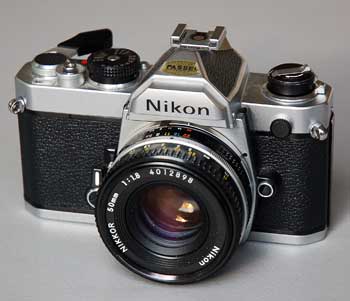
NIKON
F3
The Nikon F3 was introduced in March 1980. The proof
that the F3 is a remarkable camera is that Nikon continued to manufacture
it until that late 1990s, even though it had technically been replaced
by the F4 and later, the F5!
The
F3 was the first Nikon to be electronic dependent, although it does have
a single mechanical backup speed. The F3 was also the first camera in
the "F" series with both automatic and manual exposure modes.
The metering system was moved from the finder to the camera body. The
introduction of the optional high eyepoint finder made focusing and composing
much easier for eye glass wearers. The MD-4 motor drive attaches easily
to the bottom of the F3 and the shutter then draws its power from the
drive batteries. The F3 meter stepped away from the Nikon standard 60/40
scene measurement formula and uses an 80/20, weighted toward the light
in the center 20 percent of the scene.
Many
consider the F3 the best manual focus Nikon ever produced and the longevity
of the model reinforces that claim.
NIKON
F3 HP
The
Nikon F3 was the last manual focus model in the F series, produced from
the 1980s until the end of the century The camera has a shutter priority
auto mode as well as a full set of manual speeds. It can use the AI Nikkors
or the older non AI lenses in stop down mode. It also can use all the
later auto focus lenes except the "G" series which last aperature
scales.The "HP" model features the high eyepoint finder, agruably
the best finder ever made for folks who wear glasses. Technically the
F3 is not mechanical--it has an electronic shutter and only has one backup
mechanical speed. I might be consider a transition model.
The F3 is a heavy camera -- well built. But it is battery dependent -- if the batteries fail you have two speeds, 1/80 sec. and bulb.
Many shooters almost always use the MD-4 motor drive on the F3. The drive makes the unit much taller and heavier but gives the operator an excellent grip. Alson, when the MD-4 is installed the camera uses power from the motor drive's 8 AA batteries instead of the camera's small silver cells. This is especially helpful in cold weather.
If there is a drawback to the F3 it is that the flash syncs at 1/80 sec. -- very slow by today's standards. It has TTL flash metering but the hotshoe flash must be mounted on the Nikon "foot" -- over the rewind knob. Not very handy. It does have a PC connection for a standard flash but no TTL in that mode
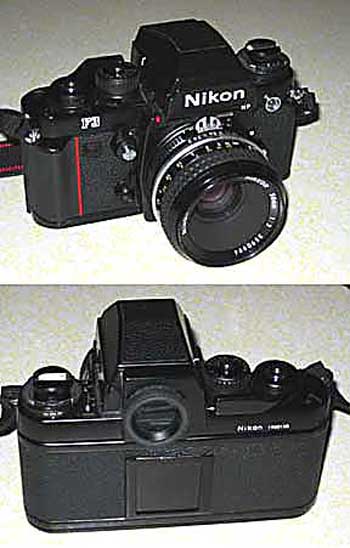
NIKON
F4
The Nikon F4 was rather controversial when introduced in September
1988. It was the first F model to come standard with autofocus and matrix
metering. It also was the first F model to be totally battery dependent.
It was offered in three models--the F4, F4s (the only model offered in
the U.S., and the F4e. The F4 is smaller than the other two models because
all four batteries are in the grip. . The F4e uses rechargable nicad batteries
and the F4s (the model shown below) uses six alkaline or lithium cells.
Several refinements were added to the F4 in a production run that lasted
until 1996. F4 fans say if looking for a used one, go for one with a serial
number that begins with 21 or higher, as all the changes were made by
that time.
The F4 was the last F model without LCD controls--conventional knobs
and switches are used. It also is the first F with a conventional hot
shoe in top of the finder instead of the Rube Goldberg connection around
the rewind knob. Nikon flashes, beginning with the SB-24, make use of
the camera's TTL flash control. The camera's autofocus system is slow
by today's standards but very usable. It does struggle with light colored
low contrast targens. The F4 has one feature not available on the F5.
It can use the older non-auto indexing Nikkor lenses by manually stopping
down the lens while taking the exposure reading. Although very heavy by
modern standards, the F4 is nearly indestructable and remains highly prized
by film shooters.
NIKON
F4s
The
Nikon F4s boasts shutter speeds from 4 seconds to 1/8000 second. There
are two program shooting modes plus shutter preferred, aperture preferred
and manual. Film can be rewound using the motor drive or a convention
manual rewind crank. It also has auto film indexing but film speed also
can be set manually. The F4 is the first F with flash sync speeds as high
as 1/250 second. That's because the old horizontal shutter has been replaced
with a vertical model with carbon fibre blades. The F4 (and all later
Nikon models) have the high eyepoint viewfinder introduced on the F3 HP.
It also has spot, 60/40 weighted and matrix metering modes. You can even
use matrix metering with older auto indexing manual focus lenses. This
camera is no lightweight. The body, with MB-21 battery pack, weighs in
at 45 ounces--almost three pounds! The MB-21 uses 6 AA alkaline or lithium
batteries. Tip: Lithium batteries are lighter than alkalines, last longer
and perform better in cold weather.
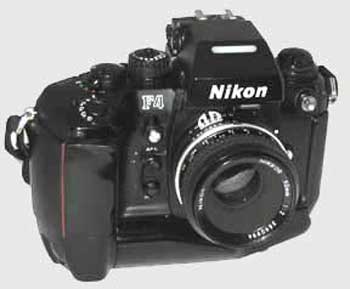
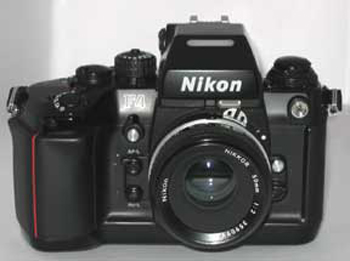
NIKON FA
The Nikon FA was introduced in 1983 and produced until
1988. It was released at the same time as the FE2 and the FM2. It was
the first Nikon with matrix metering. Only two Nikon models--the FA and
the F4--can matrix meter with manual focus AIS lenses.
The FA offers manual, aperture priority, shutter priority and program meter modes. The program mode will only work with AIS lenses, the other modes can use AI lenses. The FA has TTL metering with the appropriate flash and the shutter syncs with electronic flash up to 1/250 second. The titanium Copal shutter has a top speed of 1/4000 second. It will function without batteries at 1/250 second. The FA also had its own motor drive, the MD-15.
In many respects the FA was ahead of its time. It was advertised as a "professional" camera but many pros were skeptical of a totally electronic camera. With a retail price of more than $600 (1983 dollars) there weren't too many amateurs interested. Today, FAs in really good condition are relatively rare and fetch high proces than many contempory cameras.
The FA is a delight to shoot. The shutter is quite quiet and the cameras handles more like a manual focus DSLR than a 1983 film cameras --very smooth.
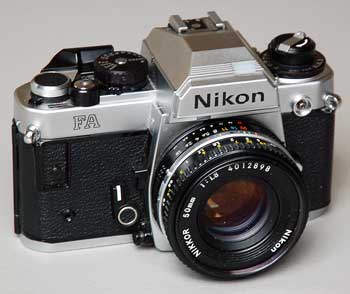
NIKON
D300
OK,
this site is supposed to be about film cameras. But I have to admit I'm
getting a lot of pleasure out of my digital SLRs. My first was a Nikon
D100 which I picked up used and hauled all over Europe in 2007. When Nikon
announced the new D300 in late 2007, I fought off the urge until January
of the following year. and sold the D100 to a family friend.
The D300 has a 3-inch LCD display on the back--with three times the resolution of any other Digital SLR on the market and a 12.3 megapixel sensor that is less suseptible to noise at higher ISO than the previous Nikon cameras. The D300 also allows me to use my old manual focus lenses.
My D300 is shown with a 20mm F2.8 Nikkor that has about the same coverage as a 28mm lens on a 35mm film camera. It can shoot at speed up to 6 frames per second--although it's unlikely I'll use that feature much
I have to admit the Digital SLRs have advanced to the point where I use one for most my shooting. I would have to invest in a more expensive film scanner in order the equal the quality of the D300 with my Nikon film cameras.
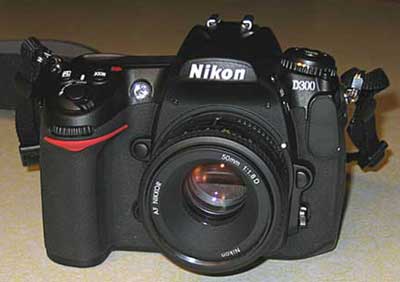
D300 with 50mm f1.8 lens.
